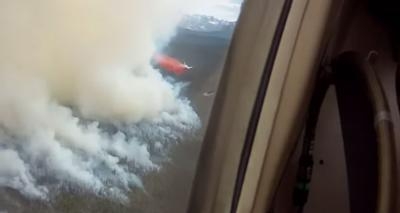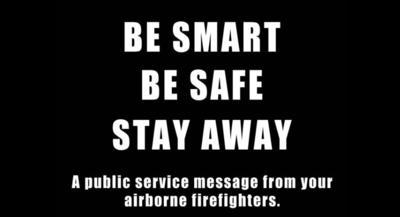Thu, Jul 30, 2015
Several Recent Incidents Reported In Which UAVs Interfered With Firefighting Aircraft
Responding to recent incidents in which unmanned aircraft systems (UAS), also known as “drones,” interfered with manned aircraft involved in wildland firefighting operations, the FAA is supporting the U.S. Department of the Interior and U.S. Forest Service in their simple message to drone operators: If you fly; we can’t.

“Flying a drone near aerial firefighting aircraft doesn’t just pose a hazard to the pilots,” said U.S. Transportation Secretary Anthony Foxx. “When aircraft are grounded because an unmanned aircraft is in the vicinity, lives are put at greater risk.”
Often a temporary flight restriction (TFR) is put in place around wildfires to protect firefighting aircraft. No one other than the agencies involved in the firefighting effort can fly any manned or unmanned aircraft in such a TFR. Anyone who violates a TFR and endangers the safety of manned aircraft could be subject to civil and/or criminal penalties. Even if there is no TFR, operating a UAS could still pose a hazard to firefighting aircraft and would violate Federal Aviation Regulations.
“The FAA’s top priority is safety. If you endanger manned aircraft or people on the ground with an unmanned aircraft, you could be liable for a fine ranging from $1,000 to a maximum of $25,000,” said FAA Administrator Michael Huerta. “Know the rules before you fly. If you don’t, serious penalties could be coming your way for jeopardizing these important missions.”
Since so many people operate unmanned aircraft with little or no aviation experience, the FAA is promoting voluntary compliance and working to educate UAS operators about how they can operate safely under current regulations and laws. The agency has partnered with industry and the modeling community in a public outreach campaign called “Know Before You Fly.”

The campaign recently reminded UAS users to respect wildfire operations. The National Interagency Fire Center also posted a video warning for users to, “Be Smart. Be Safe. Stay Away.”
Additionally, the FAA provided guidance to law enforcement agencies because they are often in the best position to deter, detect, immediately investigate, and, as appropriate, pursue enforcement actions to stop unauthorized or unsafe unmanned aircraft operations.
So remember this simple message around wildfires: If you fly, they can’t. Keep your drone on the ground and let firefighters and aircraft do their jobs. And, if you see someone flying a drone near a wildfire, report it immediately to local law enforcement and the nearest FAA Flight Standards District Office with as much information as possible.
(Images from YouTube video)
More News
From 2023 (YouTube Version): Legacy of a Titan Robert (Bob) Anderson Hoover was a fighter pilot, test pilot, flight instructor, and air show superstar. More so, Bob Hoover was an i>[...]
Get The Latest in Aviation News NOW on Instagram Are you on Instagram yet? It's been around for a few years, quietly picking up traction mostly thanks to everybody's new obsession >[...]
Aero Linx: B-52H Stratofortress The B-52H Stratofortress is a long-range, heavy bomber that can perform a variety of missions. The bomber is capable of flying at high subsonic spee>[...]
Altimeter Setting The barometric pressure reading used to adjust a pressure altimeter for variations in existing atmospheric pressure or to the standard altimeter setting (29.92).>[...]
"Knowing that we play an active part in bettering people's lives is extremely rewarding. My team and I are very thankful for the opportunity to be here and to help in any way we ca>[...]
 Classic Aero-TV: Remembering Bob Hoover
Classic Aero-TV: Remembering Bob Hoover ANN FAQ: Follow Us On Instagram!
ANN FAQ: Follow Us On Instagram! ANN's Daily Aero-Linx (05.15.24)
ANN's Daily Aero-Linx (05.15.24) ANN's Daily Aero-Term (05.15.24):Altimeter Setting
ANN's Daily Aero-Term (05.15.24):Altimeter Setting Aero-News: Quote of the Day (05.16.24)
Aero-News: Quote of the Day (05.16.24)




